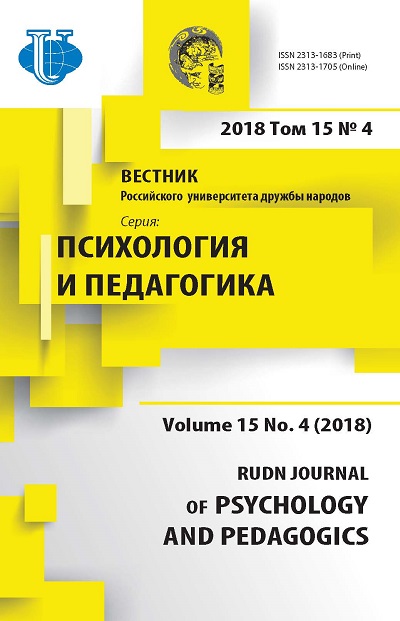Defense Mechanisms in Case of Repeat Offenders
- Authors: Bovin B.G1
-
Affiliations:
- Research Institute of the Federal Penitentiary Service of Russia
- Issue: Vol 15, No 4 (2018)
- Pages: 473-487
- Section: CLINICAL AND JURIDICAL PSYCHOLOGY
- URL: https://journals.rudn.ru/psychology-pedagogics/article/view/20375
- DOI: https://doi.org/10.22363/2313-1683-2018-15-4-473-487
Cite item
Full Text
Abstract
Recurrent crime in Russia over the years remains stable and is at least 50 %. With rare exceptions, rehabilitation programs do not have a significant impact on recidivism. After being released the professional criminals return to the previous criminal activity and everything goes in a vicious circle. It is assumed that the system of excessive or deficient functioning of defense psychological mechanisms, to a certain extent, interferes with corrective action and affects the psychological development of this type of offenders. Based on the concept of psychological defense mechanisms developed by Anna Freud, we understand the psychological defense mechanisms aimed at achieving the consistency of the inner world and the realistic adaptation of the subject to the surrounding world in order to avoid affect in a particular situation. The study involved males repeatedly convicted under various articles of the Criminal Code, i.e. convicted offenders who are in various correctional institutions of the penitentiary system of Russia. Sample size - 381 males (aged 25 to 55 years). The diagnostic questionnaire used was the Life Style Index (LSI) test, created by R. Plutchik and intended to measure the basic mechanisms of psychological defenses associated with the eight basic emotions in accordance with in the psycho-evolutionary theory of emotions. According to the theory, the defense mechanisms are understood as derivatives of the basic emotions, for the containment of which the defense mechanisms develop in the process of ontogenesis. The study identified the most primitive and the least recognized projective defense mechanism. A strategy of correction of this fixed defense based on the ideas of gestalt therapy is discussed in the article.
About the authors
Boris G Bovin
Research Institute of the Federal Penitentiary Service of Russia
Author for correspondence.
Email: bovinbg@yandex.ru
Ph.D. in Psychology, leading researcher, Research Institute of the Federal Penitentiary Service of Russia (Moscow, Russia)
14 Zhitnaya St., Moscow, 119991, Russian FederationReferences
- Antonyan, Yu.M. (Ed.) (2016). Psikhologicheskiye osnovy ispravleniya osuzhdennykh. Moscow: NII FSIN Rossii Publ. 135 p. (In Russ.)
- Bartol, K. (2004). Psikhologiya kriminal’nogo povedeniya. Moscow: Olma-press Publ. 352 p. (In Russ.)
- Blekborn, R. (2004). Psikhologiya kriminal’nogo povedeniya. Saint Petersburg: Piter Publ. 495 p. (In Russ.)
- Bovin, B.G., & Kazberov, P.N. (2014). Organizatsiya i provedeniye psikhokorrektsionnoy raboty s osuzhdennymi. In Antonyana, Yu.M. (Ed.). Ispravleniye osuzhdennykh (pp. 59—70). Moscow: FSIN Publ. (In Russ.)
- Bovin, B.G., Trubetskoy, V.F., & Chernyshkova, M.P. (2015). Psikhologiya professional’nogo prestupnika i vozmozhnosti psikhokorrektsionnogo vmeshatel’stva v yego lichnost’. Tver’: FKU NIIIT FSIN Rossii Publ. 180 p. (In Russ.)
- Conte, H.R., & Apter, A. (1995). The Life Style Index: A self-report measure of ego defenses. In Conte, H.R. & Plutchik, R. (Eds.). Publication series of the Department of Psychiatry of Albert Einstein College of Medicine of Yeshiva University, No. 10. Ego defenses: Theory and measurement (pp. 179—201). Oxford: John Wiley and Sons.
- Cramer, P. (2015). Defense mechanisms: 40 years of empirical research. Journal of Personality Assessment, 97(2), 114—122.
- Davidson, K., & MacGregor, M.W. (1998). A critical appraisal of self-report defense mechanism measures. Journal of Personality, 66(6), 965—992.
- Freyd, A. (2018). Psikhologiya «Ya» i zashchitnyye mekhanizmy. Saint Petersburg: Piter Publ. 160 p. (In Russ.)
- Gendreau, P., & Goggin, C. (2014). Practicing psychology in correctional settings. In Weiner, I.B. & Otto, R.K. (Eds.). The handbook of forensic psychology (pp. 759—793). New Jersey: John Wiley and Sons.
- Kolesnikova, A.I., & Debol’skiy, M.G. (2014). Osobennosti koping-strategiy osuzhdennykh s razlichnym urovnem zhiznestoykosti, sostoyashchikh na uchete, kak sklonnyye k suitsidu. Psikhologiya i Pravo, (4), 34—45. URL: http://psyjournals.ru/psyandlaw/2014/n4/73016.shtml (accessed: 21.10.2018). (In Russ.)
- Laplansh, Zh., & Pontalis, Zh.-B. (1996). Slovar’ po psikhoanalizu. Moscow: Vysshaya shkola Publ. 632 p. (In Russ.)
- Leybin, V. (2006). Postneklassicheskiy psikhoanaliz. Entsiklopediya. Vol. 2. Moscow: Territoriya budushchego Publ. 568 p. (In Russ.)
- Plutchik, R. (1984). Emotions: A general psycho-evolutionary theory. In Scherer, K.R. & Ekman, P. (Eds.). Approaches to emotion (pp. 197—219). Hillsdale: Erlbaum.
- Plutchik, R. (2001). The nature of emotions. American Scientist, 89(4), 344—350.
- Raygorodsky, D.Ya. (Ed.) (2016). Samosoznaniye i zashchitnyye mekhanizmy lichnosti. Samara: Bakhrakh-M Publ. 656 p. (In Russ.)
- Romanova, Ye.S., & Grebennikov, L.R. (1996). Mekhanizmy psikhologicheskoy zashchity. Genezis. Funktsionirovaniye. Diagnostika. Mytishchi: Talant Publ. 144 p. (In Russ.)
- Samovichev, Ye.G. (2001). Bessoznatel’nyye motivy prestupnogo povedeniya. In Kurbatova, T.N. (Ed.).
- Yuridicheskaya psikhologiya (pp. 119—139). Saint Petersburg: Piter Publ. (In Russ.)
- Solov’yeva, S.L. (Ed.) (2007). Spravochnik prakticheskogo psikhologa: Psikhoterapiya. Moscow: AST Publ. 575 p. (In Russ.)
- Talanov, V.L., & Malkina-Pykh, I.G. (2005). Spravochnik prakticheskogo psikhologa. Moscow: EKSMO Publ. 928 p. (In Russ.)
- Toch, H. (2014). Organizational change through individual empowerment: Applying social psychology in prisons and policing. Washington: American Psychological Association. doi: 10.1037/14373-000
















